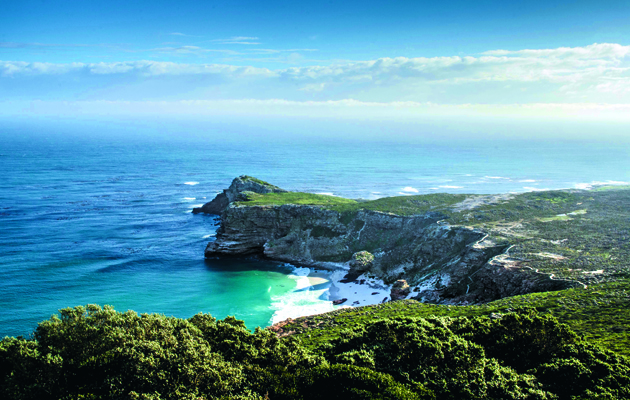Isabelle Lammens braves the Aghulas Current, bound for Namibia with two motorbikes aboard to explore the wild interior of South Africa
The coast of Southern Africa can be a cold, windy, inhospitable place, so we decided to tour South Africa and then Namibia by land. But first, we needed a safe, inexpensive berth for the boat. Knysna lagoon fit the bill – but sailing Wakataitea, our Wharram catamaran, 600 miles to get there from Durban, and then actually entering the harbour, is much easier said than done. The Knysna Heads are well known for being narrow and dangerous, prone to big swell or even breakers and the strong Aghulas current, flowing east to west, can reach 6 or 7 knots. If the wind turns west or south-west, it creates very rough seas and huge waves.
Surfing at 18 knots!
With two friendly extra crew, we planned a non-stop passage starting in an easterly breeze that picked up on the first afternoon. We logged surfing speeds of 18.3 knots with just our reefed mainsail (a crab claw sail) and the jib. The Agulhas current was pushing hard and we were flying. Wakataitea handled well, even when the wind peaked at 30 knots, sending us down one wave at 21.5 knots!
Graham, from the South Africa Maritime HAM radio net, kept us up to speed with the weather. The wind eased as he predicted after passing Port Elizabeth, then we hit a patch of doldrums and decided to motorsail. After a freezing night we caught sight of The Heads. The sea was dead calm and, following the leading lights, we entered the pass on completely calm waters.
We spent seven months in Knysna lagoon, sheltering from winter gales and touring all over the country on a pair of second- hand Yamaha TW 200 motorbikes. When summer showed up, it was time to resume sailing. Namibia, our next destination after checking out at Cape Town, has only two navigable ports, so again we planned to tour by land.
Each bike weighs 125kg and Wakataitea is 41ft long with 70m2 of deck space, so we built two wooden boxes for them, to fit between the crossbeams in front of the dodger. We took the wheels and handlebars off and wrapped the chains and brakes in plastic bags. Using the mainsail halyard, we lifted the bikes from the yacht club pontoon onto the deck and into their boxes. We added tyres, helmets and all the parts, screwed the boxes back together and secured them with straps.
When a weather window appeared, we said goodbye to our friends and sailed out of The Heads. The wind was blowing 20 knots from the south-east, too strong for the spinnaker and too far aft to safely carry the mainsail so we set up two jibs, goosewinged. We passed Cape Agulhas during the night, 20 miles off the coast. It was cold, but despite the strengthening wind our jibs are small so we kept the setup as it was.
Rounding the Cape
Although the general weather forecasts were not alarming, local conditions near the coast can be different and much stronger than predicted. Having read so many stories about navigators trying to round the Cape of Good Hope, I couldn’t help thinking about the many shipwrecks lying on the seabed in that area.
Night again: more wind and freezing temperatures. We lowered one jib and kept going with the other. We celebrated rounding the cape with a warm cup of coffee, then the wind steadily increased to over 45 knots in the gusts. We tried stopping in Hout Bay, 30 miles from Cape Town but the wind was hurtling down the mountains, laying a carpet of white spray across the water. We kept going and further out, away from the mountains, the wind eased and we returned to ‘normal’ sailing conditions.
Around midday, we arrived at Royal Cape Marina on Wednesday, 31 December, but were asleep some hours before the end of the year! We stayed a few days in Cape Town to enjoy the city before checking out, bound for Lüderitz in Namibia, 500 miles north. We cut the passage into several legs to avoid sailing in the freezing nights.
Our first stop was Dassen Island, 40 miles from Cape Town, where we saw pelicans, dolphins, seals, even a whale. Fifty miles north, we spent a few days in Saldhana Bay to let a cold front and strong winds pass by before setting off for Namibia, still 420 miles to go. The Benguela current that was pushing us north comes from the Antarctic and the southerly wind was also cold, so again we froze during our night watches. Neither of us felt very well.
On the second day, the wind eased in the afternoon then died completely, so we lowered the useless flapping sails and let the boat drift north with the current. The fog rolled in and enveloped us like a white cotton coat. The wind was still light, from astern, so we set the spinnaker. Without radar or AIS, we listened nervously for any propeller noise.
Eventually we arrived in Lüderitz, checked in and arranged a secure mooring for four weeks. The next morning we tied up at the fishing jetty, opened the wooden boxes, landed the bikes with the halyard, reassembled them that afternoon and headed off to explore.










